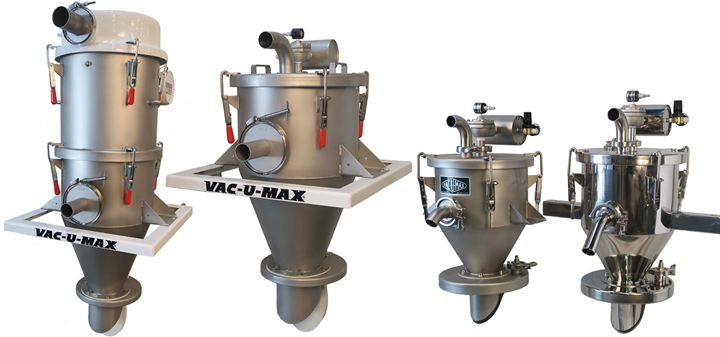Safety, Recycling, and Compounding Trends Bring New Opportunity to 70-Year-Old Company
NPE2024: Vac-U-Max presents pneumatic conveying solutions for powdered materials.
“We’ve been loving powders for 70 years,” says David Kennedy, business development manager at Vac-U-Max. The company began in 1954 with a single product, its industrial vacuum cleaner powered with compresssed air. By removing the electrical power supply as a potential source of ignition, the cleaner provides a safe way to clean up dusts, most of which are combustible in some conditions.
The descendants of that original product are still part of the company’s portfolio, along with vacuum systems for material conveying, which usually function to deliver powders from the ingredient supply to a twin-screw extruder, either directly or through a feeder system.

Vac-U-Max Signature Series conveying systems. Source: Vac-U-Max
The historical trends that impact powder conveying have only accelerated in recent years. The rise of ever more specialized materials have necessitated greater accuracy. “Compounding has become more sophisticated,” Kennedy says. “There are new kinds of functional recipes for fire resistance, for health care, for biodegradable and new hybrid products mixing plastics with other materials. There is much more need for accuracy and quality control.”
At NPE2024, Vac-U-Max will also seek to connect with businesses that are using recycled material in their products, a change from past shows where the focus would have been squarely on users of powdered ingredients.
The irregular shape and properties of recycled plastic flakes present their own challenges, and these materials are often being mixed with wood flour, fiberglass or abrasives to make composite materials. Vac-U-Max considers non-free-flowing materials such as recycled plastic waste to be its specialty. “Recycled plastics are the epitome of non-free-flowing,” Kennedy says.
As health information and labor agency have raised the bar for worker safety, minimizing exposure has become a priority for facilities. Loose dust from manual dumping and refilling can be both an inhalation and combustible hazard, and vacuum conveying can serve to minimize those issues. “Dust can build up on rafters, on top of machinery — and some of the ingredients in compounding can be an immediate health hazard,” Kennedy explains. “When you move things by vacuum conveying, even if you do have a leak, it is less of a problem.” This is because the pressure differential tends to pull dust toward the equipment rather than disperse it out into the surrounding area.
Vac-U-Max conveying systems for powders and granules can work with scales from the handful size up to 25,000 lbs/hr.
Related Content
-
Cut Loading Time Through Direct Charge Blending
Direct charge blender loading, a vacuum-powered automation process, can dramatically improve loading time and reduce material costs. In this article, we address ten common questions to help you determine if the systems are right for your facility.
-
Automated Resin Management and Blending System for Tight Spaces
NPE2024: Designed for new and existing operations with up to 10 machines and limited available space.
-
‘Digitalization’ – Awkward Term for a Vital Concept
At K 2022, 85 machines from 40 companies showed off their Industry 4.0 capabilities via OPC-UA interface. A new universal interface for Material Supply Systems was revealed at the show.





